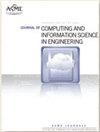Physically-based Rendering of Animated Point Clouds for eXtended Reality
IF 2.6
3区 工程技术
Q2 COMPUTER SCIENCE, INTERDISCIPLINARY APPLICATIONS
Journal of Computing and Information Science in Engineering
Pub Date : 2023-09-28
DOI:10.1115/1.4063559
引用次数: 0
Abstract
Abstract Point cloud 3D models are becoming more and more popular thanks to the spreading of scanning systems employed in many fields. When used for rendering purposes, point clouds are usually displayed with their original color acquired at scan time, without considering the lighting condition of the scene where the model is placed. This leads to a lack of realism in many contexts, especially in the case of animated point clouds employed in eXtended Reality applications where it would be desirable to have the model reacting to incoming light and integrating with the surrounding environment. This paper proposes the application of Physically Based Rendering (PBR), a rendering technique widely used in Real-Time Computer Graphics applications, to animated point cloud models for reproducing specular reflections, and achieving a photo-realistic and physically accurate look under any lighting condition. Firstly, we consider the extension of commonly used animated point cloud formats, to include normal vectors, and PBR parameters, as well as the encoding of the animated environment maps required by the technique. Then, an animated point cloud model is rendered with a shader implementing the proposed PBR method. Finally, the PBR pipeline is compared to traditional renderings of the same point cloud obtained with commonly used shaders, under different lighting conditions and environments. It will be shown how the point cloud better integrates visually with its surroundings.基于物理渲染的扩展现实动画点云
随着扫描系统在各个领域的广泛应用,点云三维模型越来越受欢迎。当用于渲染目的时,点云通常以扫描时获得的原始颜色显示,而不考虑模型所在场景的照明条件。这导致在许多情况下缺乏真实感,特别是在扩展现实应用中使用的动画点云的情况下,它希望模型对入射光做出反应并与周围环境相结合。本文提出了一种广泛应用于实时计算机图形学应用的基于物理的渲染技术(physical Based Rendering, PBR),用于动画点云模型,以再现镜面反射,并在任何光照条件下实现逼真的物理精确外观。首先,我们考虑了常用的动画点云格式的扩展,包括法向量和PBR参数,以及该技术所需的动画环境图的编码。然后,使用实现PBR方法的着色器渲染动画点云模型。最后,在不同的光照条件和环境下,将PBR管道与使用常用着色器获得的相同点云的传统渲染图进行比较。它将展示点云如何在视觉上更好地与周围环境融为一体。
本文章由计算机程序翻译,如有差异,请以英文原文为准。
求助全文
约1分钟内获得全文
求助全文
来源期刊
CiteScore
6.30
自引率
12.90%
发文量
100
审稿时长
6 months
期刊介绍:
The ASME Journal of Computing and Information Science in Engineering (JCISE) publishes articles related to Algorithms, Computational Methods, Computing Infrastructure, Computer-Interpretable Representations, Human-Computer Interfaces, Information Science, and/or System Architectures that aim to improve some aspect of product and system lifecycle (e.g., design, manufacturing, operation, maintenance, disposal, recycling etc.). Applications considered in JCISE manuscripts should be relevant to the mechanical engineering discipline. Papers can be focused on fundamental research leading to new methods, or adaptation of existing methods for new applications.
Scope: Advanced Computing Infrastructure; Artificial Intelligence; Big Data and Analytics; Collaborative Design; Computer Aided Design; Computer Aided Engineering; Computer Aided Manufacturing; Computational Foundations for Additive Manufacturing; Computational Foundations for Engineering Optimization; Computational Geometry; Computational Metrology; Computational Synthesis; Conceptual Design; Cybermanufacturing; Cyber Physical Security for Factories; Cyber Physical System Design and Operation; Data-Driven Engineering Applications; Engineering Informatics; Geometric Reasoning; GPU Computing for Design and Manufacturing; Human Computer Interfaces/Interactions; Industrial Internet of Things; Knowledge Engineering; Information Management; Inverse Methods for Engineering Applications; Machine Learning for Engineering Applications; Manufacturing Planning; Manufacturing Automation; Model-based Systems Engineering; Multiphysics Modeling and Simulation; Multiscale Modeling and Simulation; Multidisciplinary Optimization; Physics-Based Simulations; Process Modeling for Engineering Applications; Qualification, Verification and Validation of Computational Models; Symbolic Computing for Engineering Applications; Tolerance Modeling; Topology and Shape Optimization; Virtual and Augmented Reality Environments; Virtual Prototyping

 求助内容:
求助内容: 应助结果提醒方式:
应助结果提醒方式:


